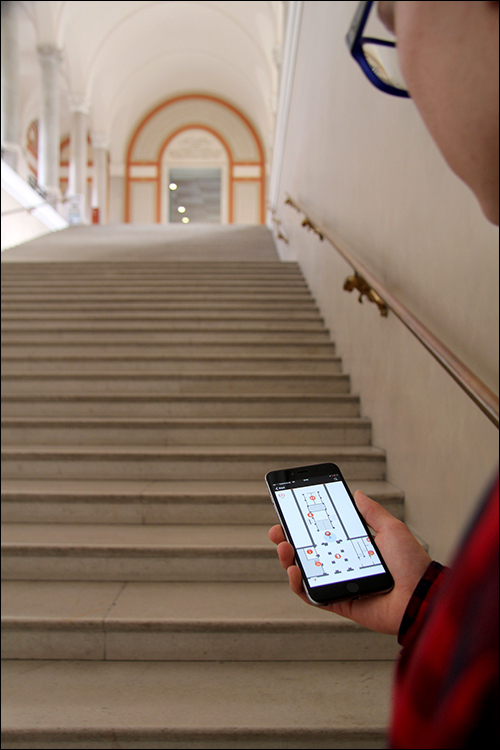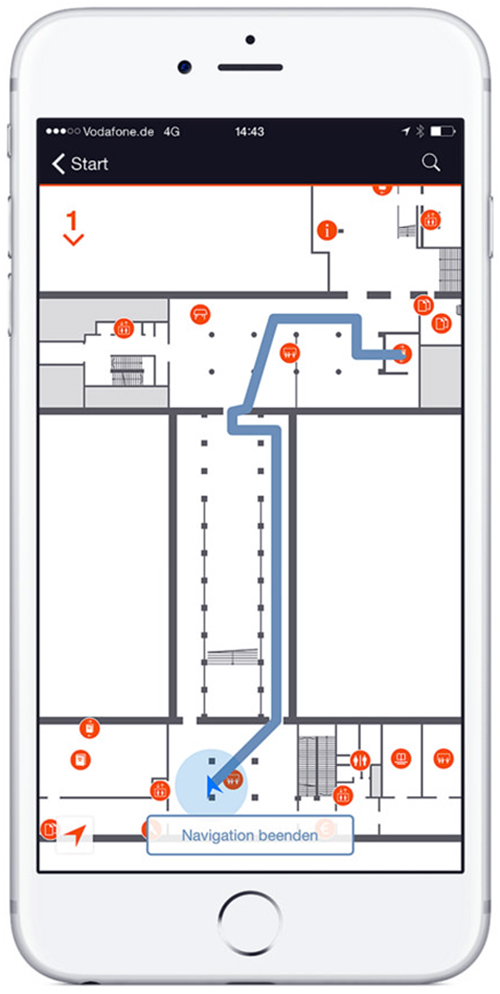Each day, more than 3,000 people visit the Bayerische Staatsbibliothek (BSB)—the Bavarian State Library—based in Munich, Germany. The building, which has historic significance, is home to 9.81 million books, as well as a number of special-interest reading rooms containing tens of thousands of reference volumes, maps and images related to such topics as Eastern Europe, the Orient and Bavarian culture. It is a grand environment, but one that can be rather tricky to navigate.
“Even I, who knows the building quite well, struggle from time to time to try to find, say, the Eastern Europe reading room. It is on the third floor, but can’t be reached by the main staircase,” says Markus Bokowsky, co-owner of Bokowsky + Laymann. Last month, the Munich-based marketing firm completed an installation of 245 Bluetooth beacons that work in conjunction with a smartphone-based wayfinding and information app called BSB Navigator. “The idea is to help [visitors] find their way more quickly and more comfortably, and without relying on library staff to guide them.”
Bokowsky says the library attracts a wide array of users from many walks of life, ranging from academia to those who come to use specialized scanning machines and others who restore historic books. “We have mapped 90 different points of interest all over the library. For instance: the cafeteria or reading room—the toilets even—scanning machines, etc.,” he says. Visitors of the millennial generation are especially focused on their phones, and this group is perhaps the most likely to embrace the app, Bokowsky says.
Since the app was only recently launched, Bokowsky adds, his firm has not yet collected sufficient feedback data to gain valuable insights into what demographic is using the app the most, or for what purpose. He declines to provide the current number of downloads. The free app is available in German or English for Apple’s iOS, through iTunes website. An Android version is expected by summer.
Bokowsky + Laymann served as the project manager and designer of the navigation system and its user interface designer. The mapping and navigation software that powers the app is licensed from indoo.rs, an Austrian startup, and Kontakt.io provided the beacons.
Because the library is a historic landmark, Bokowsky says, the beacon had to be small and discrete, but also have a replaceable battery. Kontakt.io’s beacons covered both of these requirements, he adds. In addition, the beacons can be put into sleep mode during closing hours each day, in order to extend battery life, which is important since the size of the network will make swapping out batteries an onerous task. He also likes that Kontakt.io prints the unique identification number on the beacon housing. That is one thing a user might not consider in the beginning of rolling out a network, he says, but after installing around 150 beacons, performing a visual check of each new beacon’s number, rather than having to scan it with a Bluetooth device, saves time and aggravation—especially when installing a beacon near another one that a reader might pick up simultaneously.
The algorithm that determines a user’s location in the indoo.rs mapping software is based on both triangulation and a proprietary fingerprinting technique that creates a unique map for each floor, based on slight attenuation of the beacon’s signals due to building design or obstacles or objects inside the space.
In creating BSB Navigator—which tracks a user’s location within the library to within 2 to 3 meters (6.6 to 9.8 feet) of accuracy—Bokowsky + Laymann also partnered with Bernd Brügge, a computer science professor at the Technical University of Munich, as well as his graduate students, who provided software coding services. Beyond direct navigation, the app also offers digital tours of the library and triggers supplementary information about the library’s art collection or other points of interest as users walk past these areas.

“It can also be a real challenge to convince a millennial, who’s more accustomed to looking for information on a smartphone or computer screen than in print, to visit a library over all,” says Trevor Longino, Kontakt.io’s head of product. “By improving indoor navigation for people searching through the shelves, and also adding contextual information that visitors receive on their smart devices about the building, the exhibits, the art and even the books inside, Bavarian State Library has used a new tool to keep providing the same services that it has done for nearly 400 years.”
Bokowsky declines to reveal the library’s total cost to deploy the beacon network and app. However, he notes, the collaboration with the university and student volunteers helped to keep costs relatively low.
“Big public buildings, with lots of users, will increasingly offer [visitors] indoor navigation systems,” Bokowsky says, “and our goal is providing [visitors] who are used to using phone-based navigation outdoors to also use it indoors—and with as much accuracy as you expect to have in outdoor navigation.”
The deployment was not easy, Bokowsky adds, since his firm had to evaluate around 10 different beacons before selecting those from Kontakt.io, and because the indoo.rs software is so young that between the time Bokowsky + Laymann first began working with indoo.rs and the app’s launch, the indoo.rs software developer’s kit (SDK) went through seven different updates.


